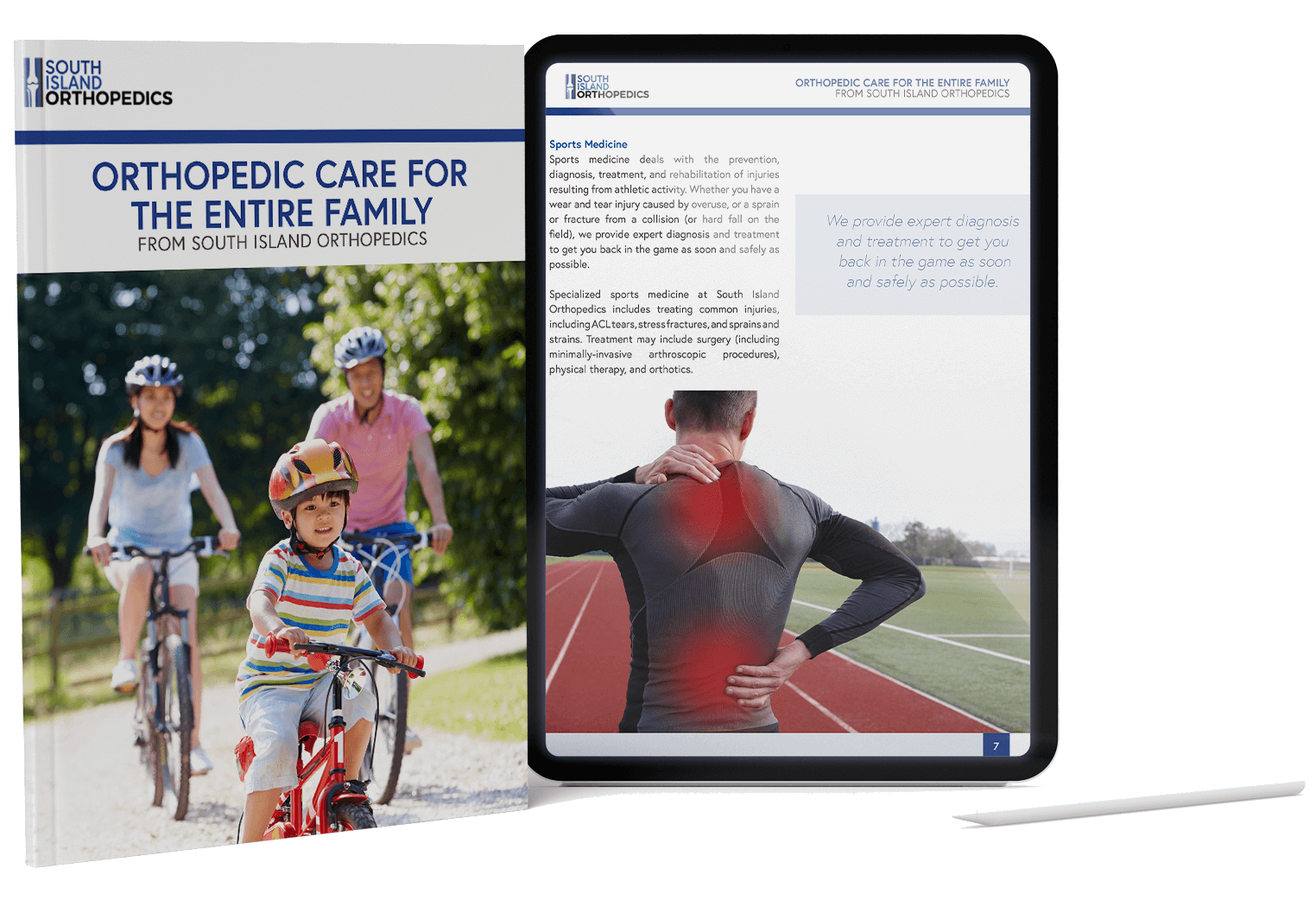7 Tips to Support Spine Health
Your spine is one of your body’s most important parts. In addition to giving your body structure and support—and allowing you to stand upright and move freely, the spine protects the spinal cord. This bundle of nerves connects your brain to the rest of your body, controlling movement and organ function. In short, without the spine, it’s practically impossible to live, let alone function.
For that reason, spine health should be a priority for everyone. Keeping your spine strong and flexible is key to avoiding common conditions that lead to back pain, injuries, and other spinal conditions that affect your quality of life.
South Island Orthopedics, including spine surgeon Dr. Franklin Lee and the rest of the orthopedic specialty team, are committed to helping patients maintain their spine health while also treating the most common spine conditions. That begins with understanding your spine and the best ways to keep it healthy—and when to get help for pain.
An Overview of the Spine
 The human spine is made up of 24 vertebrae—small bones—stacked on top of each other. In between each vertebra is a disc—a cushion made from rubbery, gel-like tissue—that keeps the bones from rubbing together and helps serve as “shock absorbers.” The vertebrae are also held together with ligaments and tendons that connect the back muscles to the spine.
The human spine is made up of 24 vertebrae—small bones—stacked on top of each other. In between each vertebra is a disc—a cushion made from rubbery, gel-like tissue—that keeps the bones from rubbing together and helps serve as “shock absorbers.” The vertebrae are also held together with ligaments and tendons that connect the back muscles to the spine.
The bones of the vertebrae are hollow, and when stacked, they create a column or tube to protect the spinal cord. There are also joints between each vertebra, which give the spine flexibility and allow range of motion. These are known as synovial joints because the ends of the bone are covered with a slippery type of cartilage that helps them move freely without creating friction.
Your spine is divided into three sections:
- The cervical spine, the top seven vertebrae. This section starts just under your skull and includes your neck. This is the most flexible and mobile part of your spine, but it’s also the most at risk for injury from strong, sudden movements or impacts.
- The thoracic spine, the next 12 vertebrae. This part of the spine connects to your ribs and is the thinnest and least flexible part of the spine. Most spinal fractures occur in the thoracic or lumbar spine, but this part of the back is also vulnerable to herniated discs and spinal deformities, such as scoliosis.
- The lumbar spine, or the bottom five vertebrae. The source of lower back pain, the lumbar spine is connected to the pelvis and bears the most body weight. The largest part of the spine, it also supports movement. This makes the lumbar spine susceptible to overuse injuries and injury due to excessive pressure, as well as herniated discs, degenerative and age-related conditions, and deformities.
Maintaining Spine Health
 Although certain spinal conditions that cause back pain are caused by age or genetics, you can reduce the likelihood of pain and injury by taking care of your spine. Simple lifestyle changes and healthy habits can go a long way toward maintaining strength and flexibility in your back.
Although certain spinal conditions that cause back pain are caused by age or genetics, you can reduce the likelihood of pain and injury by taking care of your spine. Simple lifestyle changes and healthy habits can go a long way toward maintaining strength and flexibility in your back.
To help preserve your spine health, keep these tips in mind:
- Exercise. Physical activity, especially strength training and stretches focused on the back muscles and core, can go a long way toward a healthy spine. Studies show active people are less likely to have back pain, and if they do have pain, it’s less frequent and severe.
Regular exercise strengthens the back muscles, decreases stiffness, increases mobility, and helps improve circulation, which is associated with less inflammation and faster healing. - Maintain a healthy weight. Carrying extra pounds, especially in the midsection, puts extra strain on your spine and back muscles, causing pain and other problems. If you are overweight, talk with your doctor about how you can shed extra pounds with diet and exercise.
- Stretch. Stretching helps relieve muscle tension, which contributes to back pain and preserves a healthy spine. Start each day with some gentle stretches, or take a yoga class to loosen your muscles.
- Practice proper ergonomics. Maintaining proper posture, especially when working at a computer, supports spine health. Choose a chair that provides plenty of lumbar support and allows you to sit with your feet comfortably on the floor. Get up and walk around or stretch for a few minutes every hour, as well. Sitting for long periods puts more pressure on your back, causing pain.
- Sleep well. Sleeping on a supportive mattress is associated with spine health and reduced back pain. Choose a mattress designed for your body weight and preferred sleep position, and replace it every 8-10 years. Maintaining your spine’s natural alignment helps you get a restful night’s sleep and reduces back problems like chronic low back pain. Try using different pillows to support your neck or hips to help maintain alignment and allow your muscles to fully relax.
- Stay hydrated. Dehydration and inadequate fluid intake are associated with disc problems. When your discs aren’t adequately hydrated, they can become dry and brittle and are at greater risk of slipping out of place, a condition known as a ruptured or herniated disc. Herniated discs are the leading cause of sciatica, a painful condition that occurs when a disc puts pressure on the sciatic nerve, and they can also cause significant structural damage to the spine.
- Lift correctly. Lifting heavy or bulky objects can cause muscle strain and other significant injuries to your spine. Get help when you need it, and always lift with your legs, not your back.
When to See a Spine Specialist
 Untreated spine problems will worsen and lead to complications. Spinal surgery isn’t the only spine pain treatment option, so if you have ongoing pain, stiffness, or mobility issues, seeing a spine specialist is a must. Ignoring the issue, or trying to self-medicate with over-the-counter medicines, rest, or even exercises can only make the problem worse.
Untreated spine problems will worsen and lead to complications. Spinal surgery isn’t the only spine pain treatment option, so if you have ongoing pain, stiffness, or mobility issues, seeing a spine specialist is a must. Ignoring the issue, or trying to self-medicate with over-the-counter medicines, rest, or even exercises can only make the problem worse.
If you live on Long Island, or in a neighboring borough, you have access to exceptional spine care at South Island Orthopedics. The practice’s newest physician, Dr. Franklin Lee, is a spine specialist with expertise in neck and spine conditions, and performs both minimally invasive and complex open surgical procedures, using the most advanced surgical techniques, including robot-assisted surgery.
However, like all SIO’s physicians, Dr. Lee takes a conservative approach to spine health, only recommending surgery when other treatments, including physical therapy, haven’t achieved the desired results.
Improve Your Spine Health at South Island Orthopedics
A healthy spine is integral to a healthy life. If you are concerned about your spine or living with spine pain—or any other joint or muscle problem, request an appointment at South Island Orthopedics today. With two convenient locations in Woodbury and Cedarhurst, both of which offer urgent care services for orthopedic emergencies, you can count on getting the highest standard of spine care when you need it, close to home.
South Island Orthopedics’ Guide to Bone and Joint Care

Posted in: Spine
